Explainer
- Explainer
- Border disputes
How did a Bollywood backdrop become the highest battleground on Earth?
High in the Himalayas, soldiers have fought hand-to-hand at a hotly contested border. The struggle is changing how two nuclear-armed giants see one another. Why are they fighting and what is the fallout?
By Matt Wade
The scene is classic Bollywood. Superstar Kareena Kapoor, dressed in a red wedding gown and matching helmet, rides a bright yellow scooter down a strip of sand beside a stunning Himalayan lake. Her journey ends in a romantic embrace with heartthrob Aamir Khan.
That memorable moment from the 2009 Hindi blockbuster 3 Idiots was filmed at Pangong Lake, perched 4220 metres above sea level in the Indian province of Ladakh.
Just over a decade later, the lake's green-blue waters are back in the public eye, but for a very different reason.
Above: A scene at Pangong Lake from the hit Bollywood movie 3 Idiots.
Pangong Lake is the setting for a high-stakes border standoff between India and China. A disputed frontier separating the nuclear-armed Asian giants in the western Himalayas bisects the lake.
Each side has deployed tens of thousands of troops in the region backed by tanks, artillery and missile systems. In early September, India and China accused one another of firing shots near the lake's shores. It was the first time since the mid-1970s that guns have been used at the Line of Actual Control, or LAC, the name given to the de facto border between India and China (not to be confused with the nearby "Line of Control" which delineates the parts of Kashmir administered by India and Pakistan).
The high-altitude impasse is unresolved and very dangerous. Who is doing battle? How did it get to this? And what does the Dalai Lama have to do with tensions between these powerful neighbours?
Sticks and stones? What actually happened?
In early May, “fist fights and stone-pelting” broke out between Indian and Chinese troops near the northern banks of Pangong Lake. There was a similar fracas in September last year.
While scuffles have regularly flared, there had been no combat fatalities along the LAC in more than four decades.
That changed on June 15 when a fierce brawl erupted in the desolate Galwan Valley north of Pangong Lake. Twenty Indian soldiers were killed, including a senior officer, in what the Indian government described as a “violent face-off”. The number of Chinese casualties is unknown.
No shots were fired – there was an agreement both armies would not use guns in the border area – but the brutality of the hand-to-hand combat was striking. The Indian military accused Chinese troops of using iron bars and sticks protruding with nails during the fight. Brawling reportedly took place on a narrow ridge and some troops fell into icy waters in the ravine below.
While the clash received limited attention in China’s domestic media, India’s raucous news outlets reacted with fury. The high-rating news channel Times Now described it as “China’s cowardly Galwan betrayal.” As news of the brawl broke, the channel’s veteran presenter Rahul Shivshankar shook his fist on screen saying: “The Indian side did not back down. This, viewers, is the new India. We held our ground and we hit back … the Chinese have got a measure of this new redoubtable and resolute India.”
In early September, tensions again boiled over at Pangong Lake. China and India accused one another of firing “warning shots” near the lake. That brought to an end a protocol preventing the use of firearms at the LAC which has been in place since the mid-1970s.

Indians in Lucknow burn an effigy of Chinese President Xi Jinping during a protest against the Chinese government on June 17 following clashes on the Himalayan border. Credit: AP
On August 30, India appears to have deployed soldiers on several high peaks to the south of Pangong Lake.
A few days later, the Chinese foreign ministry said Indian troops had “illegally crossed the line into the Shenpao Mountain region on the southern bank of the Pangong Lake.”
The India army claims it has not “transgressed across the LAC or resorted to [the] use of any aggressive means.”
David Brewster, a senior research fellow at the Australian National University’s National Security College, says each side has been trying to gain a site of tactical advantage in anticipation of a rival move. “It’s all about preemptive positioning,” he says.
Confidence-building measures put in place over many years to prevent bloodshed at the LAC have now been swept away says Ian Hall, professor of international relations at Griffith University. “What we are looking at now is a new normal in which there are a lot more troops deployed on the border and with the possibility of more skirmishes and violence,” he says.
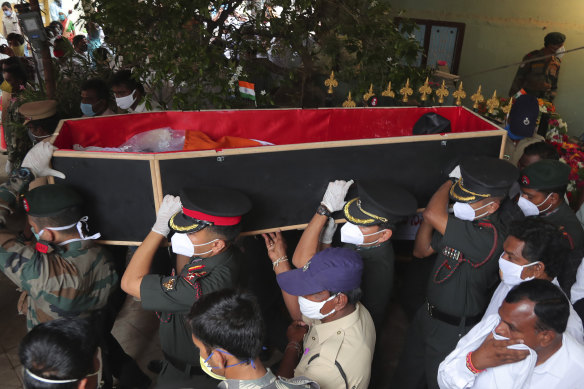
Indian army officers carry the coffin of Colonel B. Santosh Babu, killed during fighting on the China-India border in June, for his funeral in Suryapet, about 140 kilometres from Hyderabad. Credit: AP
Chinese statements have become increasingly strident. In early September, China’s foreign ministry spokesperson, Zhao Lijian, demanded that India “immediately stop making dangerous moves” and warned Chinese troops would “resolutely fulfil their duty” to defend China's territory.
“The Indian side's behaviour is a grave violation of relevant bilateral agreements, which heightened tensions and made the situation highly susceptible to misunderstanding and miscalculation,” he said. “This is a serious military provocation of an egregious nature.”
A Twitter post by Hu Xijin, the firebrand editor-in-chief of the state-owned nationalistic tabloid the Global Times, on September 11 said: “If a war breaks out, Indian army will be defeated quickly.”
Professor Hall says China is effectively saying to India “we can punish you, we can make life difficult for you and, given some of the bellicose rhetoric in recent days, if necessary we can win a war against you.”
The foreign ministers of China and India met in Moscow on September 10 and released a joint statement saying both sides would "avoid any action that could escalate matters". Local commanders from both sides met near the LAC south of Pangong Lake on September 21 for a sixth round of talks aiming to ease the military standoff.
But as yet there are no signs of a breakthrough. “There doesn’t seem to be willingness on either side to compromise,” says Hall.
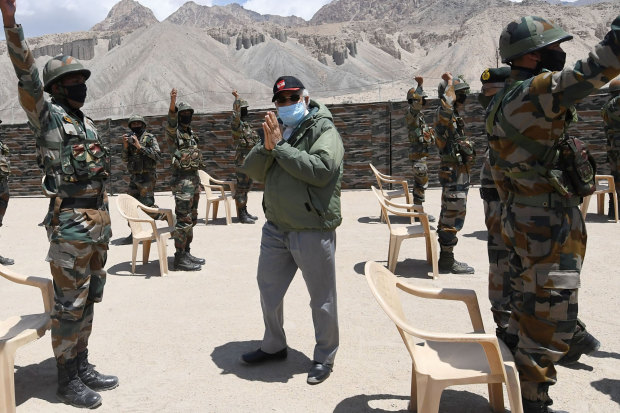
Indian Prime Minister Narendra Modi makes a surprise visit to a military base in remote Ladakh in July. Credit: Press Information Bureau via AP
How did it come to this?
The economies of China and India have become increasingly entwined during the past two decades but their political relationship is plagued by entrenched friction points, especially ill-defined borders.
In 1962, China and India fought a short but bloody border war in the same region where troops are now facing off. China was victorious and seized much of Aksai Chin, a strategically located plateau roughly the size of Switzerland.
That territory is still claimed by India and the long border separating the two nations in the western Himalayas has never been formally demarcated.
Instead, both sides have their own interpretations of the hazy Line of Actual Control. The lack of border clarity has troubled Sino-India relations for decades.
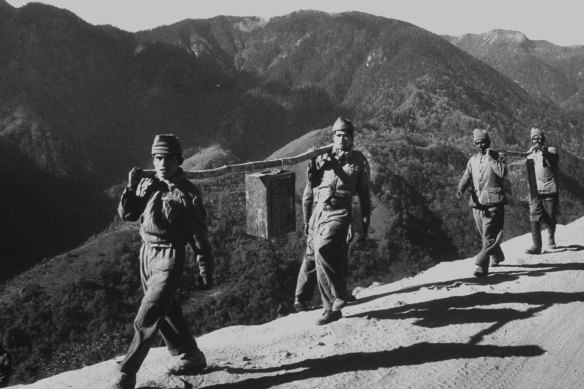
Indian troops carry ammunition during the conflict between China and India in 1962.Credit: Getty Images
The current border standoff is taking place in inhospitable terrain at very high altitude. For much of the year, troops stationed in the Himalayas contend with sub-zero temperatures, high winds, potentially fatal altitude-related illnesses and the threat of avalanches.
The financial and human cost is considerable. Specially designed or modified equipment is often required for military deployments. At the Siachen Glacier, where troops from India and Pakistan face off at another disputed border nearby, it is estimated around 2500 soldiers from both sides have died due to climatic conditions and avalanches since the mid-1980s.
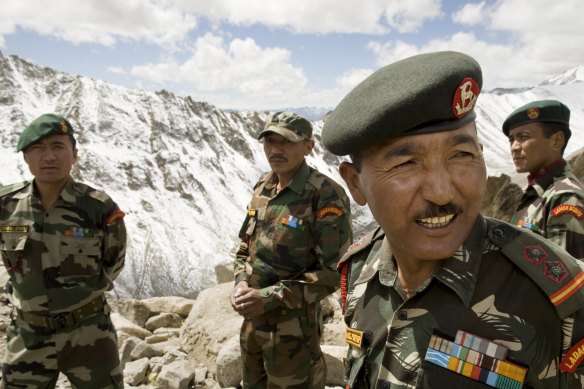
Members of the Ladakh Scouts infantry regiment – nicknamed the "Snow Warriors" – at Khardung La, a mountain pass in the Ladakh Himalayas on September 12.Credit: Getty Images
The original trigger for this year’s India-China tensions is unclear but one factor appears to be the construction of infrastructure near the contested border. This includes India’s all-weather highway, the Darbuk-Shyok-Daulat Beg Oldie (DSDBO) road, which runs close to the LAC near the Galwan Valley.
Professor Hall says that during this year’s Himalayan spring the Chinese military “moved up in force” at strategic points along the LAC and “seemed to be patrolling much more aggressively.”
Satellite imagery published in June appeared to show new Chinese military structures in the vicinity of the disputed border.
The Indian government has accused China of amassing forces in the sensitive region and of attempting to “change the status quo.”
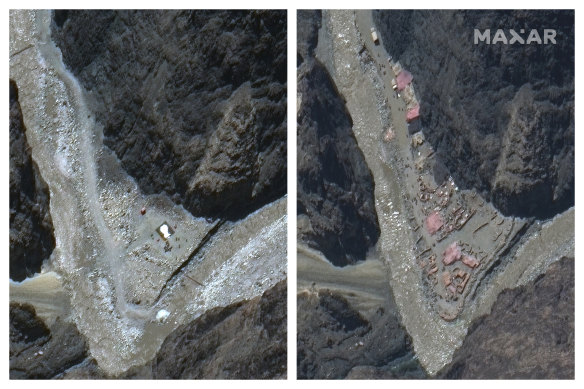
Satellite images taken on May 22 and June 23 appear to show Chinese construction in the Galwan River Valley near the Line of Actual Control between India and China. Credit: Maxar Technologies
Analysts have linked the standoffs to China’s recent assertiveness in other contested territories including the South China Sea and Hong Kong.
“China has been pressing everywhere,” says Hall.
This has happened in the midst of a distracting global pandemic. COVID-19 is spreading rapidly in India and its economy has been hit disproportionately hard by pandemic-related disruptions.
Robin Jeffrey, a research professor at the Institute of South Asian Studies at the National University of Singapore, says China's aim may have been to put India "in its place".
Beijing strongly opposed a recent decision by Indian Prime Minister Narendra Modi to alter the constitutional status of the disputed territory of Kashmir, also in the western Himalayas. The move was labelled “illegal and invalid” by China.
“There is certainly a possibility of this thing coming to further blows,” says Professor Jeffrey.
Dr Brewster warns any military escalation at the LAC is unlikely to be planned but caused by “misunderstandings” on the ground.
“I don’t think anyone can be sure where this is going to end up,” he says.

An attendant carries the new Dalai Lama, aged five or six in this photo (which dates it to around 1940), as he prepares to journey across the Himalayas to Lhasa, Tibet. Years later, he would flee to north India.Credit: Getty Images
What might the Dalai Lama have to do with it?
The Line of Actual Control that passed through Pangong Lake is not the only contested portion of the India-China border.
China claims much of the Indian state of Arunachal Pradesh in the eastern Himalayas – it considers the territory part of Tibet, which it occupied in 1950. Foreign ministry spokesperson Zhao Lijian drew fresh attention to this claim on September 7. "The Chinese government has never recognised the so-called 'Arunachal Pradesh' illegally established on the Chinese territory," he said.
The Sino-India frontier in the eastern Himalayas follows the “McMahon Line” (named after colonial official Sir Henry McMahon) drawn up in 1914 when the British ruled India. But China does not recognise the demarcation.
The historic Tawang monastery, a major centre for Tibetan Buddhism and birthplace of the sixth Dalai Lama in 1680, is on the Indian side close to the disputed border.
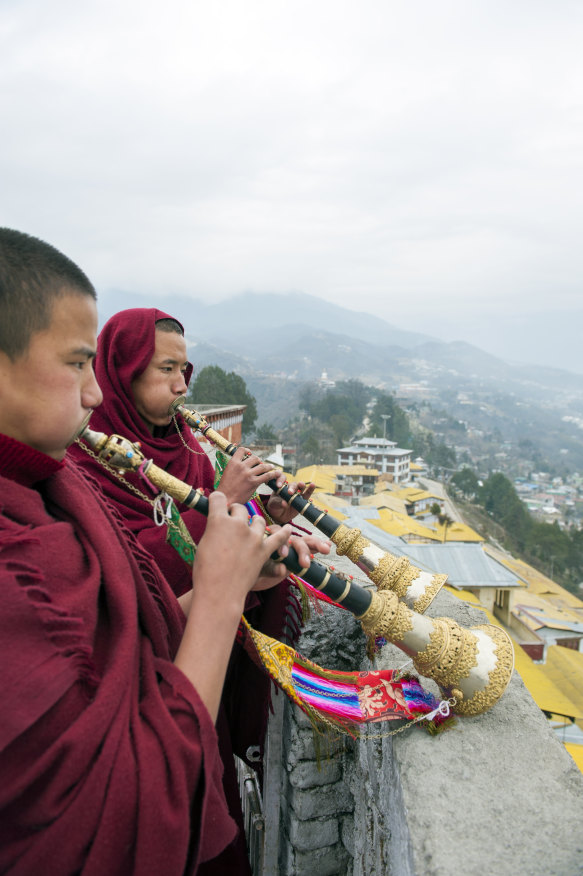
Monks blow temple horns at the Tawang monastery in the Indian state of Arunachal Pradesh. China does not recognise Indian sovereignty over much of this region.Credit: Getty Images
The current Dalai Lama fled Chinese-occupied Tibet to India in the late 1950s and has been allowed to live in India ever since. He was the original head of the Central Tibetan Administration, also known as the Tibetan government in exile, which is based in north India.
The Dalai Lama, who is now 85, remains a revered spiritual leader for many Tibetans. But Beijing considers him a trouble maker who stokes unrest in Tibet and challenges Chinese sovereignty in the region.
China may be suspicious that a successor to the current Dalai Lama will be anointed at Tawang, rather than within Chinese-controlled Tibet. If the Dalai Lama’s next reincarnation is found in a region outside Beijing’s control it could stoke another generation of opposition to Chinese rule in Tibet.
Chinese and Indian troops clashed in Arunachal Pradesh during the 1962 war and security analysts say tensions could flare again in the region.
Dr Monika Chansoria, a senior fellow at The Japan Institute of International Affairs, argues that gaining control of Tawang “remains an unfinished agenda of China’s Tibet annexation.”
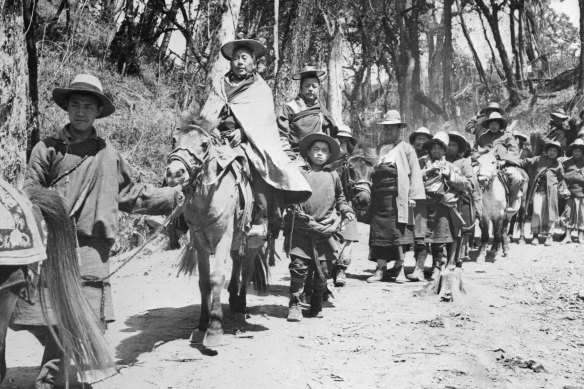
The Abbot of Tibet flees on a donkey from Tawang monastery to India in 1959. The Dalai Lama also fled, as an uprising against Chinese rule was put down in Tibet.Credit: Getty Images
It has emerged a secretive force drawn mostly from Tibetan refugees but operating with the Indian army has been involved in recent military operations at Pangong Lake. Nyima Tenzin, a member of the Special Frontier Force (SFF), is reported to have died after stepping on a land mine near the LAC in late August. His coffin was draped with the flags of both India and Tibet at a funeral ceremony held in Leh, the joint capital of Ladakh, in September.
The involvement of Tibetan soldiers in the border standoff, and the symbolic use of the Tibetan flag, is bound to irritate Beijing.
Professor Hall warns the transition to a new Dalai Lama, once the current one dies, looms as yet another “big flashpoint” for India-China relations.
Discord between New Delhi and Beijing has also been stoked by border disputes involving China and Bhutan, the small kingdom wedged between India and China in the eastern Himalayas.
In 2017, Bhutan accused China of building a road on its territory at the remote Doklam plateau. India, which has close ties with Bhutan, deployed hundreds of troops to the area and a two-month standoff followed.
A fresh controversy flared in June when China suggested Bhutan’s Sakteng Wildlife Sanctuary was “disputed” territory – the sanctuary is close to Tawang.
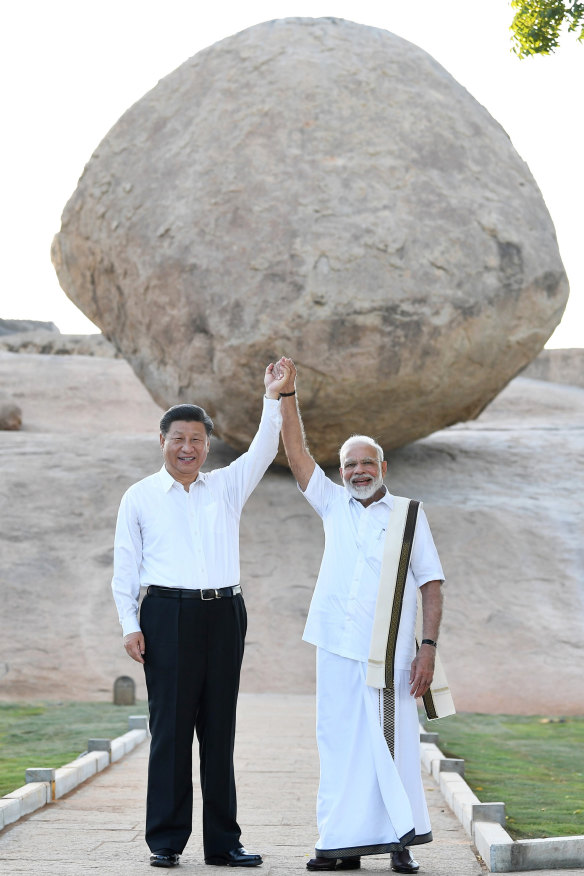
China's President, Xi Jinping, and India's leader, Narendra Modi, in Mamallapuram, India, during talks in October 2019.Credit: Indian Prime Minister's Office
What is the fallout from this dispute so far?
The rivalry between India-China will help shape global affairs for the rest of the 21st century. But their unsettled borders will be a constant irritant to the relationship – and the fallout has spread beyond the borders.
The Indian government banned the use of 59 Chinese apps, including the hugely popular TikTok, following the deadly Galwan Valley brawl in June. A further 118 apps were banned in September.
India’s retaliation threatens to undermine the strong position Chinese firms have in India’s giant digital services market.
The border conflict has also turned Indian public opinion against China. That will make it more difficult for the Indian government to be seen to walk back from the confrontation.
“There has been a real seachange in the way India looks at China,” says Brewster. “Both sides have really hardened up against each other and that leaves the door open for significant escalation based on real misunderstanding.”
Hu Xijin warns the dispute at the LAC was unlikely to be resolved quickly: “The China-India border deadlock may persist for a long time. The Chinese people should be determined and patient," he wrote in the Global Times on September 12.
Meanwhile, there is a heightened danger of escalation in October and early November because these months are considered the prime time to mount a military campaign in that part of the Himalayas. The Chinese army launched its successful 1962 offensive in that period, which is just before the onset of winter.
“One wants to hold one’s breath until some time in November when we hear the first snows have come, and it is getting really cold up there,” says Professor Jeffrey.

Pangong Lake, the site of the latest flare-up between Indian and Chinese troops.Credit: AP
correction
This article was corrected to specify the Line of Control as between China and Pakistan.
Let us explain
If you'd like some expert background on an issue or a news event, drop us a line at explainers@smh.com.au or explainers@theage.com.au. Read more explainers here.